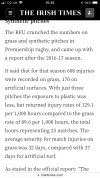- Joined
- May 20, 2008
- Messages
- 5,690
- Country Flag
- Club or Nation

I thought there are more statistical injuries on those pitches though. Will have to try and dig out the article.I never quite got why the pitch - artificial or grass - is blamed. If there was an increase in injuries playing on artificial pitches, then you'd expect teams that play at home on such pitches would incur far more injuries, yet they don't.
Annoyingly I was really looking forward to this fixture because I think Sale will certainly be up there at the end and Sale are interesting to watch. Sanderson is a quality act and actions on and off the pitch are starting to have an impact. Both teams lacking their England contingent again underlines just how stupid rugby is to have international duties on at the same time as domestic fixtures; it dilutes the brand and people feel short-changed.
Sadly, I'm out of the country so had to resolve myself to viewing tries scored on Twitter. Bit infuriating that the guys conceded three yellow cards, but again the gamesmanship appears to have shone through to neutralise the - at one-point - two-man advantage. Looking forward to watching the replay video.
7 from 7; that's a pretty good start by most accounts. Hopefully European and international fixtures doesn't derail the momentum.




